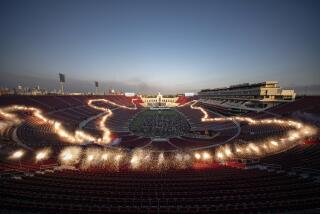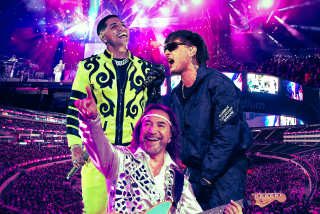The Show Must Go On, Fiesta Officials Say : Violence: Despite gang skirmishes that shortened the Cinco de Mayo celebration, organizers and city officials support the event. More precautions are urged for next year.
In the wake of disturbances that forced the early closing of Fiesta Broadway stages, organizers and city officials said Monday that they would not allow gang members to end an event that attracted more than 500,000 people Downtown.
“The defining question for the city of Los Angeles is, how much longer can our events be held hostage by gang members?” asked Estela Lopez, executive director of festival co-sponsor Miracle on Broadway.
Acknowledging that the violence Sunday had “brought into question the viability” of such events, Los Angeles City Councilman Richard Alatorre on Monday said he strongly believes that the event must go on.
“We cannot tolerate and allow an insignificant number of people to ruin an event like this,” the councilman said.
Tom Castro, president of El Dorado Communications, said: “I think there’s no question we can host these events safely. The only alternative is we all live in our houses behind bars and never see each other.
“If you want to play it safe, don’t have the event,” said Castro, whose company owns radio station KMQA-FM (La Maquina), one of the festival’s sponsors. “But if you want to play it safe, don’t get in your car. Somebody could run into you, shoot you.”
The fifth annual Fiesta Broadway, the nation’s largest Cinco de Mayo celebration, drew crowds that made some streets in the 36-block festival area nearly impassable.
The crowd was made up overwhelmingly of families and young people out to enjoy top-name Latino entertainers in a festival atmosphere. Thousands of young couples brought children, and police said there were no signs of trouble until about 300 gang members began to congregate.
Violence erupted at 4th and Spring streets when radio station KPWR-FM (Power 106) closed its stage after fire and police officials told the station that the crowd had grown too large to control. The station, which was making its first appearance at the festival, shut its stage at 2:45 p.m. as singer Stevie B. was scheduled to appear.
*
Gang members in the crowd, estimated at up to 10,000, began throwing rocks and bottles at the stage and at officers, police said. Officers, some in riot gear, fired rubber bullets and beanbag-like projectiles from 12-gauge shotguns into knots of troublemakers and began clearing streets of hundreds of thousands of people.
“We’re talking 30 guys” who started the trouble, said Paul Sansone, KPWR’s marketing director. “It’s very frustrating. A very small element ruined the chance for thousands to have a good time.”
At least 18 people were injured, apparently none seriously. Police said 14 people were arrested, most for failing to comply with an order to disperse.
Sansone said the crowd near his station’s stage was larger than the area could safely hold, and shortly after 1:30 p.m. station staffers began to notice that gang members were flashing hand signs at one another.
“There were two distinct groups, about 30, near our stage,” Sansone said. When the stage was closed, he said, “The stage was bombarded by 40-ounce beer bottles, cans and other objects.”
Event organizers assured the station that no alcohol would be sold by vendors, Sansone said. That ban was enforced, but liquor stores in the festival area were open for business, he said.
“Any time you have young people on a hot day, you don’t want alcohol,” Sansone said. “That’s like matches and dynamite.”
Alatorre said he would favor new safeguards for next year, such as banning the sale of alcohol at stores inside the festival area.
Police Lt. Michael R. Hillmann, who commanded 72 officers at 4th and Spring, said police and festival organizers recognized two weeks ago that crowd control could be a problem.
By 11:30 a.m. Sunday, Hillman said, “there was a very, very large number of people, and a very large number of gang members.”
When fighting broke out about three hours later, Hillman said he felt “some of the gang members were provoking a stampede. I had my squads break out into a line and move north on Spring.
“I told my officers to be very discriminating with the use of the rubber projectiles to avoid women and children. And over the next 30 to 40 minutes, before the dispersal was complete, we fired a total of 32 37-millimeter foam rubber baton rounds. We were shooting in front of the crowd, and there were very few women and children in our path. Most were gang members.”
*
At that point, Hillman said, “It was a riot. We had a riot situation at 4th and Spring.”
South of Spring Street, however, stages remained opened until nearly 5 p.m., and one continued until the festival’s scheduled 6 p.m. closing.
Castro said his station’s stage at 11th and Hill streets was “completely unaffected” by the violence. “South of 6th Street, you would never know anything happened down there,” he said.
Some police gang experts did not believe that the gangs arrived looking for trouble. If anything, the fact that so many rivals were willing to rub shoulders is a testament to the efforts of the Mexican Mafia prison gang in unifying thousands of Southern California street gang members, authorities said.
“These guys feel comfortable walking on the streets now because they know they’re not going to get shot,” said LAPD Detective Terry Wessel of the Rampart Division’s anti-gang CRASH unit. “Six months ago, you would have had dead bodies there.”
Everyone entering the festival’s gated entrances was searched by private security guards. Most men coming through the gates were frisked and asked to reveal the interiors of their baseball caps, one festival-goer said. Purses, even tote bags for infants, were inspected. Alcohol, weapons and food were confiscated, he said.
* HOT SOUNDS
Eclectic music is highlight of Fiesta Broadway. F1
More to Read
Sign up for Essential California
The most important California stories and recommendations in your inbox every morning.
You may occasionally receive promotional content from the Los Angeles Times.










